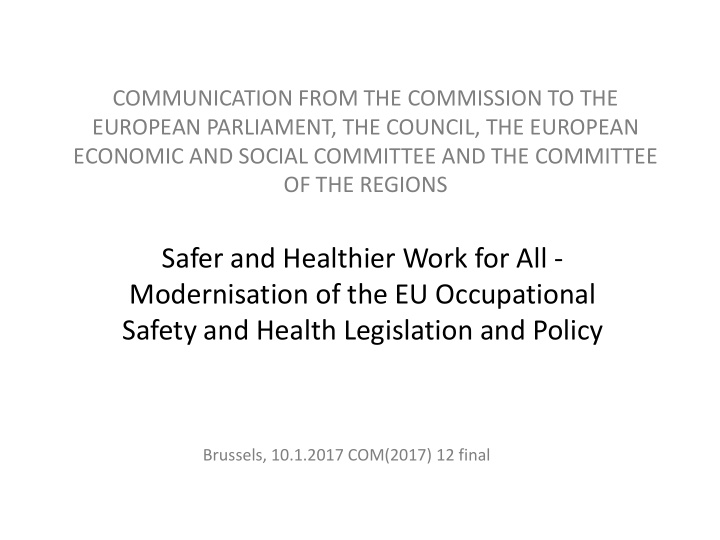



COMMUNICATION FROM THE COMMISSION TO THE EUROPEAN PARLIAMENT, THE COUNCIL, THE EUROPEAN ECONOMIC AND SOCIAL COMMITTEE AND THE COMMITTEE OF THE REGIONS Safer and Healthier Work for All - Modernisation of the EU Occupational Safety and Health Legislation and Policy Brussels, 10.1.2017 COM(2017) 12 final
• This Communication follows an ex-post evaluation of the EU acquis, checking its relevance as well as its efficiency, effectiveness, coherence and EU added value. • Carried out as part of the REFIT platform and included the Framework Directive 89/391/EEC and 23 related Directives.
EU OHS policy is contributing to the objective of improving the safety and health of workers in the EU. According to the most recent available data the incidence rate of deaths in accidents at work dropped by almost 1/4 as compared with the situation in 2008
Fatal accidents at work, 2013 and 2014 (incidence rates per 100 000 persons)
3500 10 9 3000 8 2500 7 6 2000 5 1500 4 3 1000 2 500 Injury rate 1 Fatality rate 0 0 2002 2003 2004 2005 2006 2007 2008 2009 2010 2011 2012 2013 2014 2015 2016
Main conclusions • The overall structure of the EU OHS acquis, consisting of a goal-oriented Framework Directive complemented by specific Directives, is generally effective and fit-for-purpose. • Except for technical updating of six (of 24) Directives, and possible review of Annexes to other Directives, the acquis remains intact. • The process will involve the ACSH.
OSH evaluation Comprehensive ex-post and REFIT evaluation of the EU Occupational Safety and Health (OSH) legislation (24 directives) OSH acquis is relevant but some challenges persist, e.g.: The burden of occupational cancer remains high Coverage of some groups of workers could be improved Some provisions are outdated and/or could be simplified Business, especially SMEs, needs support to better apply OSH rules Need to strengthen inspection and monitoring 7
• Need for legislation to improve protection against dangerous substances and fight occupational cancer – 2nd amendment to CMD – Subsequent amendments to include formaldehyde, beryllium, cadmium, chromium VI compounds, nickel. – More OELVs under Chemical Agents Directive
1. Fight against occupational cancer • Cancer is the first cause of work-related deaths in the EU (53%) • Every year some 102,500 people die in the EU as a consequence of occupational cancer • Proposal for a 3 rd amendment of the Carcinogens and Mutagens Directive in 2018, including important substances such as formaldehyde, cadmium and nickel compounds. • Work on better articulation between OSH and REACH
• Helping businesses comply with OSH rules • Publication on best practices: MSDs/ergonomic risks • Develop LI principles with regards to age-sensitive RA – Practical guidance document (already made available) – Increasing use of web-based tools – Help on emerging risks – MSDs, psychosocial risks, ageing population
2. Helping businesses comply with OSH rules Focus on micro and small enterprises Only 69% of microenterprises declare that they perform regular OSH risk assessments (against 96% for larger enterprises). Lack of awareness and expertise, limited resources Need for practical support 11
• Updating legislation – remove outdated rules, refocussing efforts on facilitating compliance, broader coverage of people, better enforcement
The 6 directives identified • Workplaces (89/654) : clarification of the notion of "workplace" and updating, simplifying or removing the annexes to reflect changes in ways of working • Display screen equipment (90/270): technical updates of some definitions • OSH signs (92/58): alignment of the Directive with EN ISO 7010 to ensure greater harmonisation of safety signs across the EU
• Biological agents (2000/54): update list of agents • Medical assistance on board (92/29): update the compulsory list of medical supplies • Personal protective equipment (89/656): update reference to the definition of PPE, in particular as regards the current exclusions of equipment used by emergency and rescue services • Further updates: - Carcinogens and Mutagens Directive (2004/37 - Chemical Agents Directive (98/24)
• MS encouraged to review national osh legislation – A peer review aimed at reducing administrative burden in national legislation. • MS encouraged to ensure a broad coverage of osh policies – Self-employed – Domestic workers CION encouraging MS to implement the Recommendation on self-employed, despite that about half the member States now include them in legislation. The fact that around half of the MS have OSH rules covering domestic workers may encourage other MS to follow suit. A 'civil society' conference in 2018 to measure progress.
• Enhancing enforcement and a culture of prevention – Emphasis on the role of SLIC in enforcement. – Emphasis on the role of EU-OSHA as regards data collection.
Strengthening enforcement Inspections contribute to a real prevention culture and enforcement on the ground. Tangible effects: over 20% drop in injury rates in inspected plants. Frequency of inspections vary a lot across MS. Overall, 50% of microenterprises and SMEs and 25% of larger enterprises had no inspection in the last 3 years. Quality of inspections matters a lot – need to encourage inspections going beyond mere sanctioning. Tools: better standards and guidance for inspectors, encouraging cross-agency work, improved cooperation through the Senior Labour Inspectors Committee 17
Thank you
Recommend
More recommend